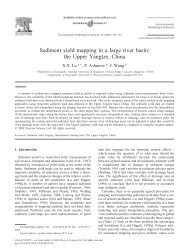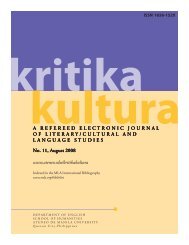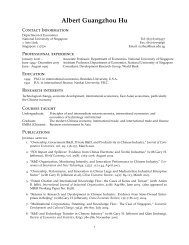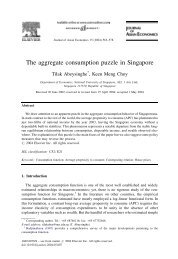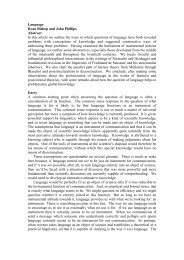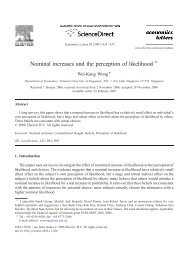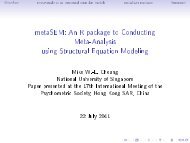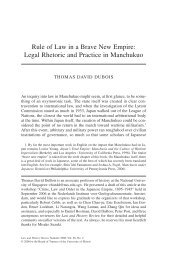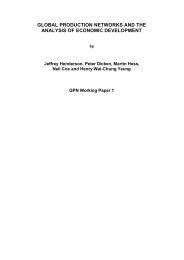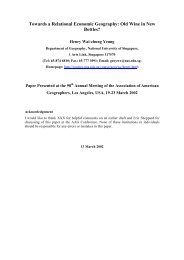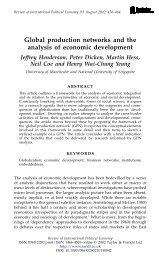BUSINESS LETTER WRITING: FORMATTING
BUSINESS LETTER WRITING: FORMATTING
BUSINESS LETTER WRITING: FORMATTING
Create successful ePaper yourself
Turn your PDF publications into a flip-book with our unique Google optimized e-Paper software.
LEARNING OBJECTIVES:<br />
<strong>BUSINESS</strong> <strong>LETTER</strong> <strong>WRITING</strong>: <strong>FORMATTING</strong><br />
To understand the key elements you need to pay attention to when formatting your<br />
business messages<br />
To ensure that your messages conform to standard business conventions<br />
I NTRODUCTION<br />
Ensuring the correct format is the mechanical part of the letter writing process. Although this<br />
may seem trivial to you, the presentation of the letter does convey a message to your reader. If<br />
you use a format that does not conform to standard business letter conventions, your letter<br />
may come across as unprofessional to the reader who may then form an unfavorable image of<br />
you and your company. Since the presentation of the message is the first thing that catches<br />
the reader’s attention, it is important that some attention be paid to format. This handout<br />
deals with the formats of letters, memos and emails.<br />
<strong>LETTER</strong>S<br />
In discussing the format of letters, it is helpful to first examine the<br />
different parts of a letter. Below are the compulsory parts of a letter and<br />
a few of the more common optional parts. There are many points worth<br />
noting with respect to the different parts of a letter.<br />
PARTS OF A <strong>LETTER</strong><br />
Letter Head Each company letterhead usually consists of the company’s logo, name,<br />
address, telephone, fax numbers and a website address.<br />
Date Line Always write out your date in full. Do not use short forms for the months<br />
and do not use numerals alone, as the date 2/10/03 could also be read as<br />
10 th of February 2003, following the American convention.<br />
Date Line –<br />
Inside<br />
Address<br />
If you know the name of your reader, then use it. Not only will it make your<br />
letter more personal, but it will also ensure that your letter reaches the<br />
person for whom it was intended more quickly.<br />
Salutation If you don’t know the name of the person you are writing to, use<br />
Week 7<br />
39 | P age<br />
©Centre for English Language Communication<br />
National University of Singapore
‘Dear Sir/Madam’. If you know the reader’s name, then you should use it.<br />
Whether you use the first name or the surname depends on your<br />
relationship with your reader.<br />
Subject Line Though the subject line is optional in letters, an effective subject line is<br />
helpful in giving the reader an indication of the letter’s content. The<br />
convention is to use a different font style for the subject line to set it apart<br />
from the body of the letter. As far as possible, try to limit the subject line to<br />
one line. Subject lines should be clear, concise and specific.<br />
Signature<br />
Block<br />
Carbon Copy<br />
Notation<br />
Blind Copy<br />
Notation<br />
Enclosure<br />
Notation<br />
e.g., ES2002 (too general)<br />
ES2002 Exam Meeting (better)<br />
When writing a subject line for a bad news message, make sure that it does<br />
not give away the bad news; keep the subject line neutral.<br />
e.g., Cut in travel and expenditure allowance (reveals the bad news)<br />
Changes in travel and expenditure allowance (better)<br />
The signature block comprises the complimentary close, the signature of the<br />
writer, and the writer’s typed name and designation. The complimentary<br />
close you use depends on the salutation you used earlier. If you have<br />
addressed your reader by the impersonal Sir/Madam, then the close you use<br />
is “Yours Faithfully”. If you have addressed your reader by name, be it a<br />
surname or a first name, you close with “Yours Sincerely”.<br />
This is used when a copy of the letter is sent to a third party who has an<br />
interest in the subject of the letter. The copy notation indicates to the<br />
addressee who else the letter has been sent to.<br />
This is used when a copy of the letter is sent to a third party who may be<br />
interested in the content of the letter but the sender does not want to reveal<br />
the identity of the third party to the addressee of the letter. The blind copy<br />
notation therefore appears only on the copy of the letter addressed to the<br />
third party, not in the copy that is sent to the addressee.<br />
The enclosure notation is used when another item like a pamphlet, form,<br />
flier or other printed material is being sent with the letter.<br />
40 | P age<br />
©Centre for English Language Communication<br />
National University of Singapore
Letter Head<br />
Date line<br />
Inside<br />
Address<br />
(including<br />
reader’s<br />
name and<br />
designation)<br />
Salutation<br />
*Subject line<br />
Signature<br />
block<br />
Figure 1: Parts of the Letter and the Block Format (using open punctuation)<br />
CHIN HO PLASTICS COMPANY<br />
Aljunied Road Complex<br />
623 Aljunied Road, #08‐01<br />
Singapore 5140236<br />
17 March 2010<br />
Mr William Tay<br />
Chairman<br />
Capra Products Ltd<br />
105 Lavender Street<br />
Singapore 123345<br />
Dear Mr Tay<br />
PROCESSING OF PROMOTIONAL FILM<br />
xxxxxxxxxxxxxxxxxxxxxxxxxxxxxxxxxxxxxxxxxxxxxxxxxxxxxxxxxxxxxxx<br />
xxxxxxxxxxxxxxxxxxxxxxxxxxxxxxxxxxxxxxxxx.<br />
xxxxxxxxxxxxxxxxxxxxxxxxxxxxxxxxxxxxxxxxxxxxxxxxxxxxxxxxxxxxxxx<br />
xxxxxxxxxxxxxxxxxxxxxxxxxxxxxxxxxxxxxxxxxxxxxxxxxxxxxxxxx.<br />
xxxxxxxxxxxxxxxxxxxxxxxxxxxxxxxxxxxxxxxxxxxxxxxxxxxxxxxxxxxxx<br />
xxxxxxxxxxxxxxxxxxxxxxxxxxxxxx.<br />
Yours sincerely<br />
Lee Poh Lin<br />
Lee Poh Lin (Ms)<br />
P.R. Manager<br />
Note: Item with asterisk is optional.<br />
The two most common business letter formats are block format and modified block format.<br />
The block format is used in Figure 1 above. Notice that all parts of the letter start at the left<br />
margin, including even the beginning of paragraphs. The modified block format can be seen in<br />
Figure 2 below. Notice that the address, date as well as the signature block do not begin from<br />
the left margin. Each paragraph is also indented.<br />
41 | P age<br />
©Centre for English Language Communication<br />
National University of Singapore
Letter Head<br />
Date line<br />
Inside<br />
Address<br />
(including<br />
reader’s<br />
name and<br />
designation)<br />
Salutation<br />
*Subject<br />
line<br />
Signature<br />
block<br />
*Carbon<br />
copy<br />
*Blind copy<br />
*Enclosure<br />
Figure 2: Modified Block Format (Using closed punctuation)<br />
Mr William Tay,<br />
Chairman,<br />
Capra Products Ltd,<br />
105 Lavender Street,<br />
Singapore 123345.<br />
Dear Mr Tay,<br />
CHIN HO PLASTICS COMPANY,<br />
Aljunied Road Complex,<br />
623 Aljunied Road, #08‐01,<br />
Singapore 5140236<br />
PROCESSING OF PROMOTIONAL FILM<br />
March 17, 2010<br />
xxxxxxxxxxxxxxxxxxxxxxxxxxxxxxxxxxxxxxxxxxxxxxxxxxxxxxxxxxxxxxxxx<br />
xxxxxxxxxxxxxxxxxxxxxxxxxxxxxxxxxxxxxxxxx.<br />
xxxxxxxxxxxxxxxxxxxxxxxxxxxxxxxxxxxxxxxxxxxxxxxxxxxxxxxxxxxxxxxxx<br />
xxxxxxxxxxxxxxxxxxxxxxxxxxxxxxxxxxxxxxxxxxxxxxxxxxxxxxxxx.<br />
xxxxxxxxxxxxxxxxxxxxxxxxxxxxxxxxxxxxxxxxxxxxxxxxxxxxxxxxxxxxxxx<br />
xxxxxxxxxxxxxxxxxxxxxxxxxxxxxx.<br />
cc. Jenny Teo, Head of Corporate Relations<br />
bcc. Shaneza Ashraf<br />
Enc. (2)<br />
Note: Items with asterisks are optional.<br />
Yours sincerely,<br />
Lee Poh Lin<br />
Lee Poh Lin (Ms)<br />
P.R. Manager<br />
42 | P age<br />
©Centre for English Language Communication<br />
National University of Singapore
As a letter writer, you also need to be aware of the possible punctuation styles to use as<br />
punctuation also forms part of the presentation of the letter. The punctuation being considered<br />
here is the punctuation for all the parts of the letter except the body.<br />
There are three basic punctuation styles to choose from. First, there is the closed style. This<br />
involves the use of commas in the date, inside address, after the salutation and after the close.<br />
Please note that in the American convention, a colon instead of a comma is used after the<br />
salutation. Figure 2 displays the closed punctuation style.<br />
Next, there is the open style, in which punctuation is very minimal; only full‐stops for<br />
abbreviations and commas where necessary are used (please see Figure 1).<br />
Finally, there is the mixed style, which follows the open style but commas are inserted after the<br />
salutation and close.<br />
MEMOS<br />
As mentioned in Business Letter Writing: Introduction, memos are written communications<br />
circulated within a business organization. As such memos may be written in a less formal tone<br />
than letters because both the writer and reader of memos are part of the same organization.<br />
However, just like letters, the degree of formality would be dictated by the position of the<br />
writer in relation to the reader as well as the purpose and subject of the communication.<br />
Figure 3 on the next page shows the memo format.<br />
PARTS OF A MEMO<br />
To Line Interoffice memos may be addressed to an individual, several individuals, a<br />
division or department, or all personnel. Courtesy titles (Mrs, Mr, Ms, and so<br />
on) are usually omitted in memo headings. However, it is fairly common to<br />
include designations like Vice President, Sales Manager, and so on.<br />
From Line Again, writers of memos do not usually include courtesy titles but may<br />
indicate their designation and department for identification purposes and to<br />
facilitate a response.<br />
Subject Line The subject line in a memo is a standard element of it and is not optional. It<br />
serves as the title of your message just as it does in letters.<br />
Date Line As with letters, the date should be written in full.<br />
43 | P age<br />
©Centre for English Language Communication<br />
National University of Singapore
Unlike letters, memos do not require the formality of an inside address, salutation, or<br />
complimentary closing.<br />
The normal practice is to just sign your initials at the end of the memo. However, some people<br />
prefer to sign their initials after their typed name in the ‘From’ line.<br />
Each company letterhead usually consists of the company’s logo, name, address, telephone, fax<br />
numbers and a website address.<br />
To Line<br />
From Line<br />
Subject<br />
Line Date<br />
Line<br />
Figure 3: MEMORANDUM<br />
TO: Mr. Nicholas Tay, Division Head (Administration)<br />
FROM: Yong Chin Hee<br />
SUBJECT: Inventory Control Procedures<br />
DATE: 21 July 2010<br />
xxxxxxxxxxxxxxxxxxxxxxxxxxxxxxxxxxxxxxxxxxxxxxxxxxxxxxxxxxxxxxxxxxxxxxxxxx.<br />
xxxxxxxxxxxxxxxxxxxxxxxxxxxxxxxxxxxxxxxxxxxxxxxxxxxxxxxxxxxxxxxxxxxxxxxxxxx<br />
xxxxxxxxxxxxxxxxxxxxxxxxxxxxxxxxxxxxxxxxxxxxxxxxxxx.<br />
xxxxxxxxxxxxxxxxxxxxxxxxxxxxxxxxxxxxxxxxxxxxxxxxxxxxxxxxxxxxxxxxxxxxxxxxxxx<br />
xxxxxxxxxxxxxxxxxxxxxxxxxxxxxxxxxxxxxxxxxxxxxxxxxxxx.<br />
1. xxxxxxxxxxxxxxxxxxxxxxxxxxxxxxxxxxxxxxxxxxxxxxxxxxxxxxxxxxxxxxxxxxxxxxx<br />
xxxxxxxxxxxxxxxxxxxxxxxxxxxxxxxxxxxxxxxxxxxxxxxxxxxxxxxxxxx.<br />
2. xxxxxxxxxxxxxxxxxxxxxxxxxxxxxxxxxxxxxxxxxxxxxxxxxxxxxxxxxxxxxxxxxxxxxxx<br />
xxxxxxxxxxxxxxxxxxxxxxxxxxxxxxxxxxxxxx.<br />
3. xxxxxxxxxxxxxxxxxxxxxxxxxxxxxxxxxxxxxxxxxxxxxxxxxxxxxxxxxxxxxxxxxxxxxxx<br />
xxxxxxxx.<br />
xxxxxxxxxxxxxxxxxxxxxxxxxxxxxxxxxxxxxxxxxxxxxxxxxxxxxxxxxxxxxxxxxxxxxxxxxxx<br />
xxxxxxxxxxxxxxxxxxxxx.<br />
YCH<br />
cc: Wan Peck Ling<br />
44 | P age<br />
©Centre for English Language Communication<br />
National University of Singapore
EMAILS<br />
Sending emails<br />
When sending an email, the computer puts in the date, time of day,<br />
and your name and email address automatically. What you need to<br />
do is:<br />
indicate the recipient(s) in the ”To” line<br />
decide who else needs to have a carbon copy of the email<br />
include a subject line<br />
choose the appropriate level of importance and sensitivity, if<br />
needed.<br />
In addition, you also need to decide on the appropriate salutations<br />
and complimentary closes to use as well as the signature block to include, if any.<br />
PARTS OF AN EMAIL<br />
To Line If you are sending the email to a few recipients of different positions in an<br />
organization, ensure that the addresses are sequenced correctly, with the<br />
highest ranking person coming first.<br />
Cc Line In sending a carbon copy of the email, make sure that you send it only to<br />
people who need to know.<br />
Subject Line It is helpful to always insert a subject line for an email message to give the<br />
recipient a good idea of the content to make response and filing easier.<br />
Your readers may get so many messages that they may delete emails from<br />
senders they do not recognize or if subject lines do not catch their attention.<br />
Thus, compose SMART subject lines that are specific, meaningful,<br />
appropriate, relevant and thoughtful. Here are some examples of good<br />
email subject lines:<br />
Full sponsorship to attend the TLHE 2009 Conference<br />
IT Security Advisory: Beware of new Internet Explorer vulnerability being<br />
exploited<br />
Venue for Annual Review Interview<br />
Again, in negative letters, it is advisable not to write subject lines that give<br />
away that bad news. For example, instead of writing “Termination of your<br />
contract”, an alternative line is “Matters concerning your contract” which is<br />
still SMART.<br />
45 | P age<br />
©Centre for English Language Communication<br />
National University of Singapore
Level of<br />
Sensitivity and<br />
Importance<br />
By default, new email messages are classified as 'normal' in their level of<br />
sensitivity and importance. However, for emails that contain confidential<br />
information or require urgent attention, the level of sensitivity (private,<br />
personal, confidential) and/or urgency (high) of the message should be<br />
appropriately selected.<br />
Salutations In a formal business message, it is appropriate to include a salutation Dear<br />
so and so. The salutations can be left out for routine internal email to<br />
colleagues whom you know well and are more or less on par in terms of the<br />
positions you hold in the company. Leaving out the salutations in emails<br />
sent to senior or new staff and outsiders can be considered disrespectful<br />
and unfriendly, but the company culture should tell you whether this is so.<br />
Complimentary<br />
Closes<br />
Signature<br />
blocks<br />
Most email writers prefer complimentary closes like “Regards”, “Best<br />
regards”, “Thanks and regards”, “Best wishes”, “All the best” to “Yours<br />
sincerely” or “Yours faithfully”. However, the last two complimentary closes<br />
are still used in formal email messages. In internal email communication,<br />
you can do away with a complimentary close but make it a habit to always<br />
indicate your name at the end of your message as it does make the message<br />
come across as more friendly and personal.<br />
For external email messages, it is useful to include a complete signature<br />
block that includes:<br />
Your full name<br />
Your position<br />
The name of your department<br />
The name of the organization<br />
Complete snail mail address<br />
Telephone no.<br />
Email address<br />
Website address, if available<br />
A trimmed down version of the signature block might be useful to include<br />
for internal email communication across departments. Information that can<br />
be left out includes the name of the organization and its snail mail address.<br />
46 | P age<br />
©Centre for English Language Communication<br />
National University of Singapore
Replying to emails<br />
When you reply to a message, the email system automatically creates a subject line “Re:<br />
[subject line of message to which you are responding]”. If the subject line is suitable, use it but<br />
otherwise change it to a new more relevant subject line. Do not send emails back and forth<br />
with the same subject line even when the communication has drifted to a whole different<br />
subject.<br />
In addition, when you are replying to an email sent to a list of people, use prudence in hitting<br />
the “Reply to All” button. Ask yourself if everyone needs to have your response or if only the<br />
sender needs to have it. The important thing here again is that you do not want to inundate<br />
people’s Email Inbox with unnecessary messages.<br />
Below are some pointers on the do’s and don’ts in writing business emails.<br />
Business e-mails: Do’s and don’ts<br />
o Use underlining or bold typeface to emphasize certain words.<br />
o Don’t put the whole message in caps as it indicates shouting and can appear rude and<br />
threatening.<br />
o Don't use all lowercase letters as they make your message appear too informal.<br />
o Don’t use abbreviations/emoticons. Again, this makes your message appear very<br />
informal.<br />
o Always accompany attachments with a short message.<br />
o Never send angry messages by email.<br />
o Keep sensitive information offline as far as possible.<br />
o Check accuracy of your message before clicking on<br />
“Send”.<br />
o Reply your email in a day or two. This is common<br />
courtesy, even if it is just to say that detailed<br />
response will be sent later.<br />
47 | P age<br />
©Centre for English Language Communication<br />
National University of Singapore



